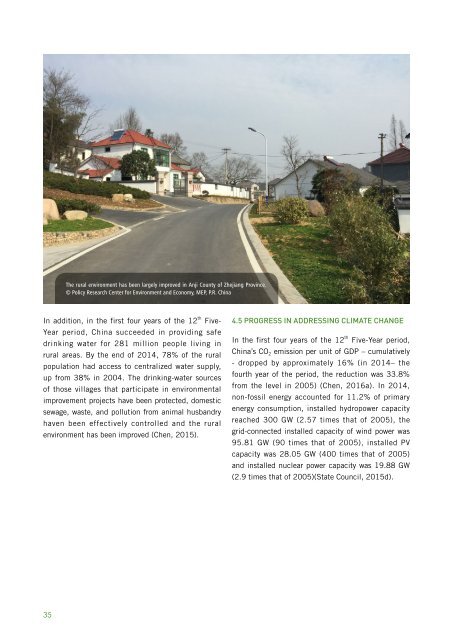GREEN IS GOLD
greenisgold_en_20160519
greenisgold_en_20160519
Create successful ePaper yourself
Turn your PDF publications into a flip-book with our unique Google optimized e-Paper software.
The rural environment has been largely improved in Anji County of Zhejiang Province.<br />
© Policy Research Center for Environment and Economy, MEP, P.R. China<br />
In addition, in the first four years of the 12 th Five-<br />
Year period, China succeeded in providing safe<br />
drinking water for 281 million people living in<br />
rural areas. By the end of 2014, 78% of the rural<br />
population had access to centralized water supply,<br />
up from 38% in 2004. The drinking-water sources<br />
of those villages that participate in environmental<br />
improvement projects have been protected, domestic<br />
sewage, waste, and pollution from animal husbandry<br />
haven been effectively controlled and the rural<br />
environment has been improved (Chen, 2015).<br />
4.5 Progress in addressing climate change<br />
In the first four years of the 12 th Five-Year period,<br />
China’s CO 2 emission per unit of GDP – cumulatively<br />
- dropped by approximately 16% (in 2014– the<br />
fourth year of the period, the reduction was 33.8%<br />
from the level in 2005) (Chen, 2016a). In 2014,<br />
non-fossil energy accounted for 11.2% of primary<br />
energy consumption, installed hydropower capacity<br />
reached 300 GW (2.57 times that of 2005), the<br />
grid-connected installed capacity of wind power was<br />
95.81 GW (90 times that of 2005), installed PV<br />
capacity was 28.05 GW (400 times that of 2005)<br />
and installed nuclear power capacity was 19.88 GW<br />
(2.9 times that of 2005)(State Council, 2015d).<br />
35


